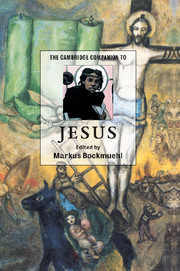Book contents
- Frontmatter
- Introduction
- Part I The Jesus of history
- Part II The History of Jesus
- 8 Sources and methods
- 9 Quests for the historical Jesus
- 10 The quest for the real Jesus
- 11 Many gospels, one Jesus?
- 12 The Christ of the Old and New Testaments
- 13 Jesus in Christian doctrine
- 14 A history of faith in Jesus
- 15 The global Jesus
- 16 Jerusalem after Jesus
- 17 The future of Jesus Christ
- Bibliography
- General Index
- Scripture Index
16 - Jerusalem after Jesus
from Part II - The History of Jesus
Published online by Cambridge University Press: 28 May 2006
- Frontmatter
- Introduction
- Part I The Jesus of history
- Part II The History of Jesus
- 8 Sources and methods
- 9 Quests for the historical Jesus
- 10 The quest for the real Jesus
- 11 Many gospels, one Jesus?
- 12 The Christ of the Old and New Testaments
- 13 Jesus in Christian doctrine
- 14 A history of faith in Jesus
- 15 The global Jesus
- 16 Jerusalem after Jesus
- 17 The future of Jesus Christ
- Bibliography
- General Index
- Scripture Index
Summary
As the gospels testify, Jesus was hardly drawn to Jerusalem. The turning-point verse in Luke's Gospel underscores the tension: 'he set his face resolutely towards Jerusalem' (9.51 NEB). Moreover, after his resurrection that same Gospel directs his disciples to proclaim 'repentance bringing the forgiveness of sins . . . to all nations beginning from Jerusalem' (24.47), as they are sent (in the companion narrative of the Acts of the Apostles) to 'bear witness for me in Jerusalem, and throughout Judaea and Samaria, and even in the farthest corners of the earth' (Acts 1.8). So the New Testament explicitly reverses the centripetal movement of all nations gathering to Jerusalem (in the messianic prophecies of Isaiah) to a centrifugal one, leaving Jerusalem to be a centre whose role would remain ambiguous throughout Christian history. In her masterful account, Karen Armstrong (1996) delineates these ambiguities through a history punctuated and shaped by diverse interactions with Jews and Muslims. Peter Walker (1990) provides an early set of reflections from Eusebius and Cyril (see also Walker 1994), while Robert Wilken (1992) offers textual evidence of the richly theological exchange between Jews and Christians in the context of this holy city. Frank Peters (1985) offers a rich compendium of texts from 'chroniclers, visitors, pilgrims and prophets from the days of Abraham to the beginning of modern times'.
- Type
- Chapter
- Information
- The Cambridge Companion to Jesus , pp. 250 - 264Publisher: Cambridge University PressPrint publication year: 2001

